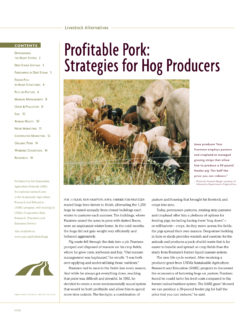Working Conditions
Labor, a huge factor in the life of any farmer, takes on a new perspective in hog operations. Toxic gases and associated offensive odors from manure produced as part of a confined system remain a major concern, while producers trying alternative housing systems report few or no problems.
'There's no comparison,' said Mark Moulton, a Rush City, Minn., swine producer who uses a deep straw system. In a hoop barn, 'there's no runoff, there are no lagoons and no gases. The smell doesn't compare.'
When Moulton's neighbors saw him building hoop barns, they were concerned about pungent odors wafting across their fields. Over the past few years, however, they have found their fears groundless. Moulton invited them and others to a picnic 10 feet from his hoop house.
'You couldn't smell a thing,' he said.
For producers, working with animals directly can be more rewarding than shoveling grain to pigs in crates. The systems require more attention and pig handling, which many producers relish.
'It's relatively easy, the pigs will teach you how to do it,' Honeyman said, 'and it can be rewarding if you like working with animals.' Hogs, which Honeyman said may be smarter than dogs, are fun to work with.
Alternative swine production systems are for people 'who like managing animals rather than equipment and machinery,' he continued. 'One reason people raise animals is because they want contact with them. In confinement, we've automated ourselves into managers of the system rather than working animals.'
Dwight Ault, who has raised hogs for more than four decades, genuinely enjoys working with pigs. Once he switched to winter farrowing in a deep-straw system, he found he could hone his husbandry skills. 'It's wonderfully productive,' he said of the system. 'It gives me more time with the hogs and a chance to observe.'
Health
Research has turned up potentially troubling information about the health of workers in confinement systems. David Schwartz, a University of Iowa pulmonary specialist, and other researchers found that workers were prone to upper respiratory disorders from lungs inflamed from exposure to grain dust, airborne particles of fecal matter, and other debris and gases such as ammonia, hydrogen sulfide, carbon dioxide and carbon monoxide from hog manure in confinement barns.
Workers in confinement buildings have greater incidence of acute respiratory illness with symptoms such as coughing, sore throats, runny noses, burning or watering of eyes, shortness of breath and wheezing, chronic bronchitis, and inflammation, wrote Kelly Donham of the Iowa Center for Agricultural Safety and Health in the Journal of Agromedicine. Others have reported reduced lung function.
The dust and gases blamed for such ailments are much less prevalent, or nonexistent, in alternatives such as hoop structures or pasture systems. Moreover, alternative system producers do not administer antibiotics for disease prevention. Administering antibiotics to livestock has been blamed for lowering the effectiveness of those medicines for the treatment of human health problems because indiscriminate use encourages the evolution of new strains of bacteria immune to drugs.
